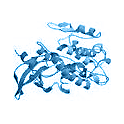
- Remove this product from my favorite's list.
- Add this product to my list of favorites.
Products
Newsletter
 |  |  |  |  |  |

Background: Protein kinase C (PKC) is a family of serine-threonine kinases, which are classified into three major groups: classical (α, β and γ), novel (δ, ε, η, and θ) and atypical (μ, ξ and ι). PKCν (PKC nu) or PKD3 has 77.3% similarity to human PKC mu (PKCμ) and 77.4% similarity to mouse PKD and belongs to the protein kinase D family of serine/threonine kinases. The lack of the typical pseudosubstrate site as well as the presence of two hydrophobic domains (diacylglycerol binding C1 domains) and the presence of a pleckstrin homology (PH) domain in the regulator region are characteristic features of this enzyme. PKC-nu / PKD3 is an important component of signaling pathways downstream from novel PKC enzymes as a downstream effector for BCR (B-cell antigen receptor)-mediated DAG production.
Human Protein kinase C (PKC) nu / PKD3, recombinant and active enzyme, full lenght protein, untagged, expressed in Sf9 insect cells
Theoretical MW : 100.793 kDa (fusion proteins)
Expression system: Baculovirus infected Sf9 cells
Purification: GST-Affinity Chromatography followed by 3C mediated removal of the GST tag
Storage buffer: 50 mM HEPES pH 7.5, 100 mM NaCl, 5 mM DTT, 20% glycerol
Protein concentration: 0.122 mg/ml (Bradford method using BSA as standard protein)
Method for determination of Km value & specific activity: Filter binding assay MSPH membrane
Specific activity : 16,000 pmol/mg min
Entrez Gene ID 23683
UniProtKB O94806
Ordering information: shipped on dry ice
Hayashi,A. et al: PKCnu, a new member of the protein kinase C family, composes a fourth subfamily with PKCmu. Biochim Biophys Acta. 1999 May 6;1450(1):99-106.
Matthews SA, Dayalu R, Thompson LJ, Scharenberg AM.(2003) “Regulation of protein kinase Cnu by the B-cell antigen receptor.” J Biol Chem. 14;278(11):9086-91
Recombinant human Protein Kinase C (PKC) alpha, 10 µg - 465,00 €
PKC substrate, 1mg - 150,00 €
Recombinant human Protein kinase C (PKC) beta 1, 10 µg - 465,00 €
Recombinant human Protein kinase C (PKC) beta 2, 10 µg - 465,00 €
Recombinant human Protein kinase C (PKC) delta, 10 µg - 465,00 €
Welcome Login
Contact us
Follow us